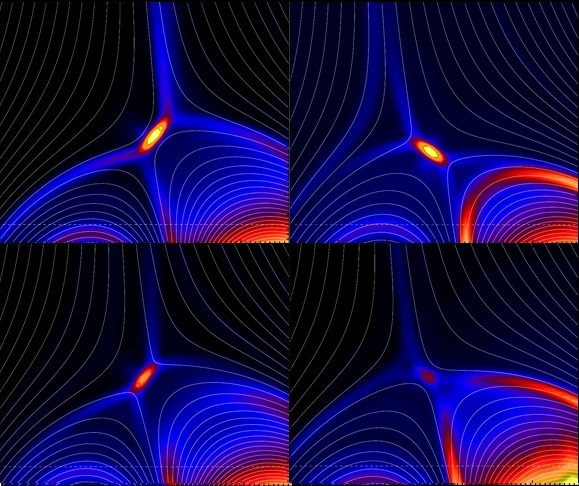2023.01.13 RAS Specialist Discussion Meeting:
New generation multi-dimensional (2D/3D) and multi-scale modelling of solar flares
from reconnection to particle energisation and beyond
- Venue: Burlington House, London, UK
- Submission deadline: Sunday 27th November 2022.
- Status: Completed
- Social: After the meeting we will be defaulting to social drinks at Chequers Tavern near Burlington House They also serve standard British pub food.
- Registration: Registration is required whether attending online or in-person. RAS Specialist discussion meetings are free to Fellows and £5 (online) or £15 (in-person) for non-fellows. RAS Fellows can login to book using the fellows website at https://fellows.ras.ac.uk/
- Chairs: Dr Malcolm Druett (KU Leuven, Belgium), Dr Natasha Jeffrey (Northumbria University, UK)
- Invited speakers:
- James McLaughlin, Northumbria University, "Magnetic Reconnection in 2D/3D."
- Sophie Masson, Observatoire de Paris, "Solar flare energetic particle acceleration."
- Chengcai Shen, Harvard Centre for Astrophysics, "Comprehensive solar flare models in 3D."
Meeting Abstract
Solar flares are the result of many complex large and small scale plasma processes occurring in the Sun’s atmosphere. Driven by access to the latest generation of High-Performance Computing (HPC) services, higher dimensional models of solar flares are finally becoming feasible and a series of flagship 3D flare simulations have recently been published in high impact journals. Thus, we stand at a key point in time to evaluate and discuss the essential inclusions, assumptions, and simplifications in flare modelling. These will steer models made in the future, in terms of accurately reproducing physics and observational features from the upcoming generation of satellite, and ground-based observatories. In this meeting, we will highlight the fundamental differences in behaviours between higher-dimensional models and their lower dimensional counterparts. We will explore the benefits and drawbacks of different approaches applied in order to make 3D modelling feasible in the current era of computing. To do this, we solicit contributions covering complementary themes, designed to bring together important aspects of comprehensively modelling solar flares in 2D and 3D.
This session has three complementary themes, designed to cover, and bring together, important aspects of comprehensively modelling solar flares in 2D and 3D. Specifically:
- Magnetic reconnection in 2D and 3D:
- Discuss new findings regarding magnetic island formation and fragmentation, and the results of time-varying oscillatory reconnection.
- Discuss effective ways to handle the multi-scale nature of models that include accurate magnetic reconnection regions in large-scale atmospheres.
- From reconnection to particle energisation:
- Discuss the state-of-the-art regarding combined reconnection and particle modelling and linking the kinetic and macroscopic scales.
- Discuss how we connect energisation, escape and transport over extended regions, in non-uniform plasma conditions and in realistic magnetic field configurations.
- Benefits and drawbacks of 2D and 3D flare modelling.
- What essential physics must be retained from detailed 1D simulations in the step up to 3D flare simulations? Which assumptions and approximations are available that maintain realistic physics whilst enabling 3D simulations using modern High-Performance Computing (HPC) facilities?
- Discuss new insights gained from 3D models of flares. How do they agree and differ from observations? What needs to be done to address existing differences?
 Image credit: McLaughlin et al. 2012
Image credit: McLaughlin et al. 2012
 Conference photo 1: in the RAS library.
Conference photo 1: in the RAS library.
 Conference photo 2: in the RAS library.
Conference photo 2: in the RAS library.
 Conference in progress: Boris Gudiksen presenting his work undertaken with Lars Frogner using the Bifrost code to implement energetic particle beams.
Conference in progress: Boris Gudiksen presenting his work undertaken with Lars Frogner using the Bifrost code to implement energetic particle beams.
 Conference in progress: Wenzhi Ruan presenting his work undertaken with Rony Keppens using MPI-AMRVAC to simulate flares in 3D.
Conference in progress: Wenzhi Ruan presenting his work undertaken with Rony Keppens using MPI-AMRVAC to simulate flares in 3D.
 Conference Venue: Burlington House, home of the Royal Astronomical Society.
Conference Venue: Burlington House, home of the Royal Astronomical Society.
 Carrington Event: In the library of the RAS, Carrington's full disk drawing of the "Carrington Event" solar flare of 1859.
Carrington Event: In the library of the RAS, Carrington's full disk drawing of the "Carrington Event" solar flare of 1859.